Input interpretation

cyclopropane
Chemical names and formulas
![formula | C_3H_6 name | cyclopropane alternate names | cyclopropane [INN] | cyclopropnane | trimethylene | trimethylene (cyclic) mass fractions | C (carbon) 85.6% | H (hydrogen) 14.4%](../image_source/891afd3788613864fc6cd083c0998f88.png)
formula | C_3H_6 name | cyclopropane alternate names | cyclopropane [INN] | cyclopropnane | trimethylene | trimethylene (cyclic) mass fractions | C (carbon) 85.6% | H (hydrogen) 14.4%
Lewis structure
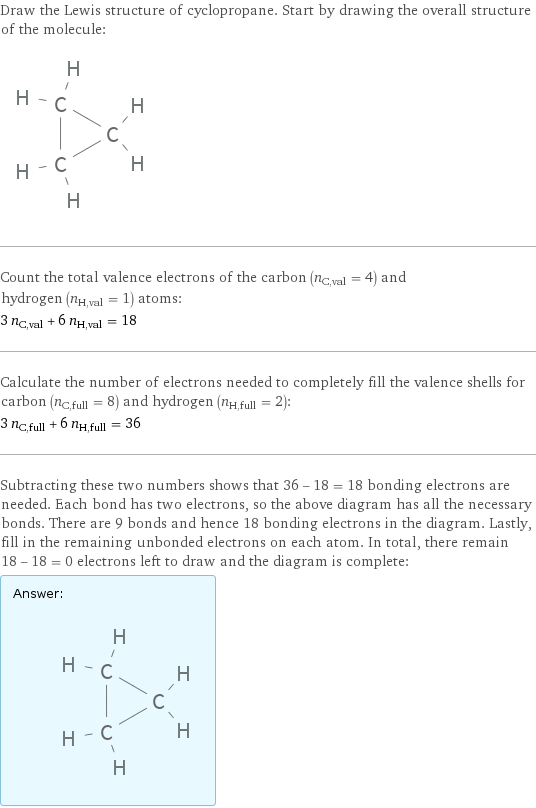
Draw the Lewis structure of cyclopropane. Start by drawing the overall structure of the molecule: Count the total valence electrons of the carbon (n_C, val = 4) and hydrogen (n_H, val = 1) atoms: 3 n_C, val + 6 n_H, val = 18 Calculate the number of electrons needed to completely fill the valence shells for carbon (n_C, full = 8) and hydrogen (n_H, full = 2): 3 n_C, full + 6 n_H, full = 36 Subtracting these two numbers shows that 36 - 18 = 18 bonding electrons are needed. Each bond has two electrons, so the above diagram has all the necessary bonds. There are 9 bonds and hence 18 bonding electrons in the diagram. Lastly, fill in the remaining unbonded electrons on each atom. In total, there remain 18 - 18 = 0 electrons left to draw and the diagram is complete: Answer: | |
3D structure

3D structure
Basic properties

molar mass | 42.081 g/mol phase | gas (at STP) melting point | -128 °C boiling point | -33 °C density | 0.784 g/cm^3 (at -101 °C) solubility in water | slightly soluble dielectric constant | 1.002
Gas properties (at STP)
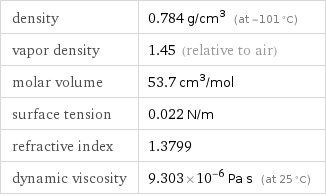
density | 0.784 g/cm^3 (at -101 °C) vapor density | 1.45 (relative to air) molar volume | 53.7 cm^3/mol surface tension | 0.022 N/m refractive index | 1.3799 dynamic viscosity | 9.303×10^-6 Pa s (at 25 °C)
Units

Thermodynamic properties
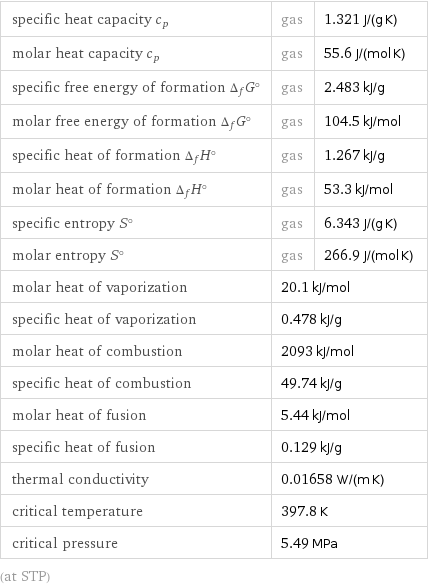
specific heat capacity c_p | gas | 1.321 J/(g K) molar heat capacity c_p | gas | 55.6 J/(mol K) specific free energy of formation Δ_fG° | gas | 2.483 kJ/g molar free energy of formation Δ_fG° | gas | 104.5 kJ/mol specific heat of formation Δ_fH° | gas | 1.267 kJ/g molar heat of formation Δ_fH° | gas | 53.3 kJ/mol specific entropy S° | gas | 6.343 J/(g K) molar entropy S° | gas | 266.9 J/(mol K) molar heat of vaporization | 20.1 kJ/mol | specific heat of vaporization | 0.478 kJ/g | molar heat of combustion | 2093 kJ/mol | specific heat of combustion | 49.74 kJ/g | molar heat of fusion | 5.44 kJ/mol | specific heat of fusion | 0.129 kJ/g | thermal conductivity | 0.01658 W/(m K) | critical temperature | 397.8 K | critical pressure | 5.49 MPa | (at STP)
Phase diagram
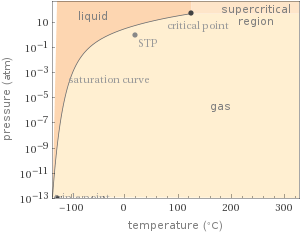
Phase diagram
Units

Chemical identifiers
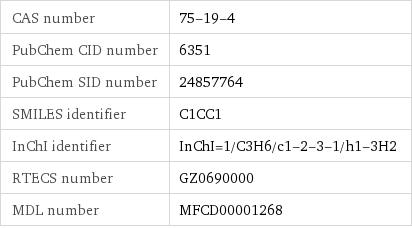
CAS number | 75-19-4 PubChem CID number | 6351 PubChem SID number | 24857764 SMILES identifier | C1CC1 InChI identifier | InChI=1/C3H6/c1-2-3-1/h1-3H2 RTECS number | GZ0690000 MDL number | MFCD00001268
NFPA label

NFPA label
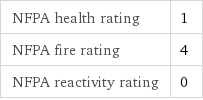
NFPA health rating | 1 NFPA fire rating | 4 NFPA reactivity rating | 0
Safety properties
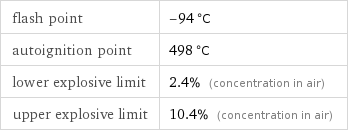
flash point | -94 °C autoignition point | 498 °C lower explosive limit | 2.4% (concentration in air) upper explosive limit | 10.4% (concentration in air)

DOT hazard class | 2.1 DOT numbers | 1027
Toxicity properties

RTECS classes | tumorigen | mutagen